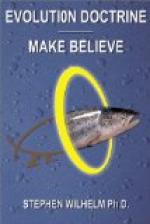Nowadays the problems in this well-organized department are concerned not only with more accurate accounts of the development of animals, but also with the mechanics of development, with the relative value of external and internal influences, and above all with the physical basis of inheritance. It is clear that the factors that direct the development of a wood frog’s egg so that it becomes a wood-frog and not a tree-toad must lie in the egg itself, as derivatives from the two parent organisms. Weismann and his followers have proved that a peculiar substance in the nuclei of the egg and its daughter-products contains the essential factors of development, whatever these may be. Experiments dealing with the phenomena of heredity in pure and mixed breeds have largely confirmed Weismann’s doctrine, and they have prepared the way for a deeper investigation of the marvelous process of biological inheritance.
However much he may be interested in the details of embryological science, the general student of natural history is more concerned with the bearing of its primary laws upon the great problem of evolution. In the foregoing brief review of the fundamental facts and principles of this subject, the purpose has been to show how the phenomena of development are viewed by men of science, and how they take their place in the doctrine of organic evolution. And it has also been made plain that comparative anatomy and comparative embryology support and supplement one another in countless ways and places, although each in itself is a complete demonstration that evolution is a real and a natural process.
III
THE EVIDENCE OF FOSSIL REMAINS
Few natural objects appeal to the interest and imagination of the student with more force than the fragments of animals and plants released from the rocks where they have been entombed for ages. Our lives are so brief that it is impossible for us to comprehend the full duration of the slow process which constructed the burial shrouds of these creatures of long ago. We try to picture the earth and its inhabitants as they were when lizards were the highest forms of animals, and we wonder how life was lived in the dense forests of the coal age. Science can never learn all about the ancient history of the earth and of the organisms of bygone times; yet it has been able to accomplish much through its endeavors to reconstruct the past, for its method is one by which sure results can always be obtained whenever there are definite facts with which it can work. In our present study of evolution we reach the point when we must examine the testimony of the rocks, and the results and methods of that department of knowledge called palaeontology, which is concerned with fossils and their interpretation.




